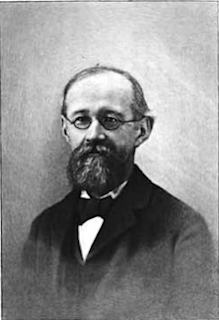
Who is Charles Ammin Cutter?
Charles
Ammi Cutter was a american librarian, was born in Boston,
Massachusetts in March 14 of 1837 and died in September 6 of 1903 in
Walpole, New Hampshire. He was responsible of the creation of the
Cutter Expansive Classification, The
rules for a printed dictionary catalogue and the Table
Cutter-Sanborn.Charles
Ammi Cutter.
The Cutter life's and Work
In his early life, Cutter was enrolled into the Harvard Divinity School in 1856, to become in a cleric. He was appointed assistan librarian of the Divinity School while still a student there, and serverd in that capacity from 1857 to 1859. He graduated in 1860, but did not practice as a cleric and joined as a cataloger in the library of Hardvard University. In that time Cutter began a designing a new cataloging schema when the professor Gottfried Christian Friedrich Lücke of University of Göttingen donated his bibliografic collection to Harvard University, wich added much depth to the Divinity School Library's collection.
Remains in the library of Harvard until 1868, where begined to worked in the Boston Athenaeum library as its head librarian, there continued researched new advances in the library science and created their "Rules for a printed dictionary catalogue" in 1876, the system of classifiaction "Cutter Expansive Classification" in 1880 and the table of signatures "Table Cutter-Sanborn".
In
1876, Charles Cutter participated in the creation of the American
Library Association a nonprofit organization based in United Stetes
that promotes libraries and libray education internationally. Also
was the editor of the magazine Library Journal between 1891 and 1893.
Cutter left the Boston Athenaeum library in 1893, because he could not introduced new reforms. But there was an opportunity in Northampton, Massachusetts. Judge Charles E. Forbes left a considerable amount of money to the town to start a library that was called Forbes Library.
Cutter set up the art and music department and encouraged children of nearby schools to exhibit their art. He also established branch libraries and instituted a traveling library system much like the bookmobile. Unfortunately, he died in 1903 before he could finish the development of the library.
The
relevance of Charles Ammi Cutter
The relevance of Charles Ammi Cutter
Charles
Ammi Cutter was a visionary in the field of library Science, a proof
of that is this declaration in the Library Journal in 1883: "The
desks had... a little keyboard at each, connected by a wire. The
reader had only to find the mark of his book in the catalog, touch a
few lettered or numbered keys, and [the book] appeared after an
astonishingly short interval."
Without
people like Charles Ammi Cutter, maybe the actual paradigm isn't were
the same to which we know it. Because
their advances and contributions like the implementation of the music
and art to the convencional library helped to changed the old vision
and mission of the libraries to a new concept. A place where all kind
of information in any formart is put to disposition of all kind the
user, a place to stay not a place to research, take a book and leave. He
believed which the libraries should attend in the better way possible
in special to the children, because they are the future, the next
generation of readers and students.
Finally, the creation of the Rules for a printed dictionary catalogue helped as a base to create the Sears Subject Headings by Minnie Earl Sears a simplification of the Library of Congress Subject Headings , which still used today. Also the Cutter Expansive Classification was the basis for the top categories of the Library of Congress Classification.
For all that reasons, for me, Charles Ammi Cutter is a central and influencial figure in the LIS (Library Information Sciences) and a person worthy to remember.
Finally, the creation of the Rules for a printed dictionary catalogue helped as a base to create the Sears Subject Headings by Minnie Earl Sears a simplification of the Library of Congress Subject Headings , which still used today. Also the Cutter Expansive Classification was the basis for the top categories of the Library of Congress Classification.
For all that reasons, for me, Charles Ammi Cutter is a central and influencial figure in the LIS (Library Information Sciences) and a person worthy to remember.